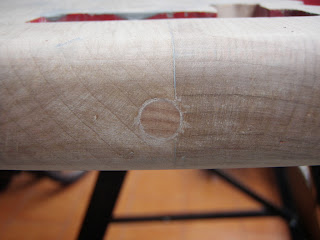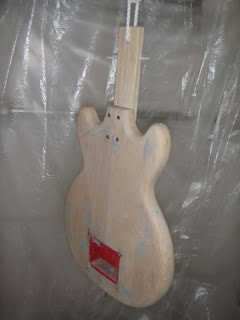
In the last blog post, we lacquered the neck on our vintage Hofner Colorama II guitar. Today we will paint the body.
Before painting, we do a last check for anything we may have missed, like scrapes or gouges in the wood. This leads us to discover that the raw plug/screw anchor that someone had inserted to hold on the rear strap button, and which we were just going to leave, is, in fact, just half a raw plug.

So, out it comes:

A new hole is drilled:

A wooden plug is cut:

Glued in:

And filed/sanded flat:

Finally, we drill a new strap button hole:

Et voilà.

Also, since we're at it, let's drill a hole from the control cavity through to the tremolo area, so that we can earth (ground) the tremolo unit when we put this thing back together:

Now on with the show. A quick mounting system needs to be fabricated, so we cut a piece of wood that can be attached to the neck pocket. We drill a hole in it too, so that we can hang it up. We’ll also put a screw in the rear strap button hole to give us another contact point to move the guitar body around while we’re spraying it.

We give the guitar body a quick wipe down to remove any dust, etc:

Now here’s the body hanging up in our specially-designed spray booth (the spare bathroom, which, btw, has very good ventilation). We make sure to wear suitable eye and mouth/nose protection before proceeding:

And so the spraying begins. We're just using standard car (auto touch-up) paint spray cans for this:

Here’s the body after a layer or two. As you can see, the body filler is showing through. However the original paint job had no primer/undercoat, and we want to keep it that way, so we will keep applying layers until the filler is no longer visible:


After a few more layers there is no sign of the filler:


Here’s the guitar body after two cans of spray paint. We’ll hang it up to dry for a week or two and then sand it with very fine sandpaper. If necessary, some additional layers of paint will be applied. After that, it will receive some lacquer (which will be shown in later posts):

Comments
Post a Comment